Both the Little Boy and Fat Man atomic bombs were detonated high in the air above their target cities. That they did this was no accident — specialized circuitry, some invented just for the atomic bombs, was used so that the bombs could detect their height off of the ground and detonate at just the right moment. Little Boy detonated 1,968±50 feet above Hiroshima, Fat Man detonated 1,650±10 feet above Nagasaki. At least as early as the May 1945 Target Committee meeting at Los Alamos, “the criteria for determining height” of detonation had been agreed upon: the goal was to maximize the 5 psi (pounds-per-square-inch) overpressure blast radius of the bombs, with a knowledge that this was going to be a tricky thing since they weren’t really sure how explosively large the bombs would be, and a bomb either too big or too large would reduce the total range of the 5 psi radius. At the time, they estimated Little Boy would be between 5 and 15 kilotons, Fat Man between 0.7 and 5 kilotons — obviously this was pre-“Trinity,” which showed the Fat Man model could go at least up to 18-20 kilotons.
I was on the road quite a lot the last month, so I apologize about the radio silence for the past couple of weeks. But I’m happy to report to you that I managed to recently update the NUKEMAP’s effects code in a way I’ve been meaning to for a long while: you can now set arbitrary heights for detonations. I thought I would explain a little bit about how that works, and why that matters, in today’s post.
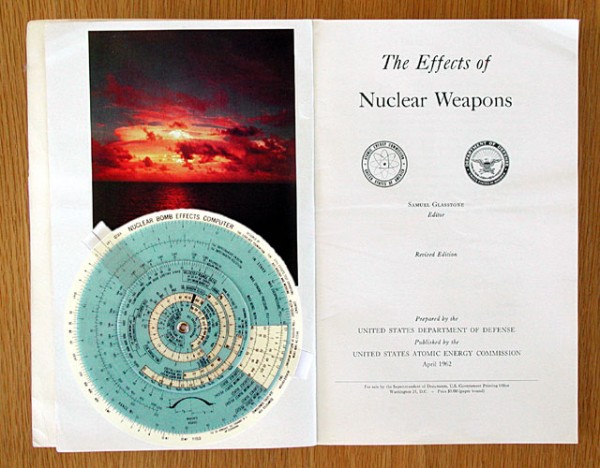
The 1962 edition of Glasstone’s The Effects of Nuclear Weapons and the Lovelace Foundation’s “Nuclear Bomb Effects Computer.”
Why did it take me so long to add a burst height feature? (A feature that, to both me and many others alike, was obviously lacking.) Much of the NUKEMAP’s code is based on the calculations that went into making the famous Lovelace Foundation “Nuclear Bomb Effects Computer,” which itself were based on equations in Samuel Glasstone’s classic The Effects of Nuclear Weapons. This circular slide rule has some wonderful retro charm, and is a useful way of boiling down a lot of nuclear effects data into a simple analog “computer.” However, like most nuclear effects calculations, it wasn’t really designed with the kind of visualization that the NUKEMAP had in mind. For something like the NUKEMAP, one wants to be able to plug in a yield and a “desired” overpressure (such as 5 psi), and get a measurement of the ground range of the effect as a result. But this isn’t how the Lovelace Computer works. Instead, you put in your kilotonnage and the distance you want to know the overpressure at, and in return you get a maximum overpressure in the form of pounds-per-square-inch. In other words, instead of asking, “what’s the distance for 5 psi for a 15 kiloton surface burst?,” you are only allowed to ask, “if I was 2 miles from a 15 kiloton surface burst, what would the overpressure be?”
For surface bursts and a few low height (400 feet and under) airbursts, the Lovelace Foundation did, in a separate report, provide equations of the sort useful for the NUKEMAP, and the NUKEMAP’s code was originally based on these. But they didn’t allow for anything fancy with regards to arbitrary-height airbursts. They let one look for pressure information at “optimal” airburst heights, but did not let one actually set a specific airburst height. For awhile I thought this might just have been a strange oversight, but the more I dug into the issue, I realized this was probably because the physics of airbursts is hard.

Grim geometry: calculating the ground range of the 500 rem radiation exposure radius for a Hiroshima-sized nuclear weapon set off at the height of the Hiroshima bomb. Most objects roughly to scale.
There are three immediate effects of nuclear weapons that the NUKEMAP models: thermal radiation (heat), ionizing radiation (radioactivity), and overpressure (blast). Thermal and ionizing radiation pretty much travels in a straight line, so if you know the slant-line distance for a given effect, it’s no problem figuring out the ground distance at an arbitrary height through a simple application of the Pythagorean theorem, as shown above. The report the Lovelace Computer was based on allowed for the calculation of slant-line airburst distances for both of these, so that was a snap to implement. Somewhat interestingly, the ranges of the “interesting” thermal radiation categories (e.g. burns and burning) are so large that except with very high airbursts one often finds almost no difference between ground ranges computed using slant versus straight-line distances. Ionizing radiation, however, is relatively short in its effects, and so the height of the burst really does matter in practical terms for how much radiation the ground receives. This has a relevance to Hiroshima and Nagasaki that I will return to.
But this isn’t how the physics of blast pressure works. The reason is somewhat subtle but important for understanding nuclear weapons targeting decisions. The pressure wave that emerges from the nuclear fireball does not stop when it hits the ground. Rather, it reflects — bounces upward again — like so:
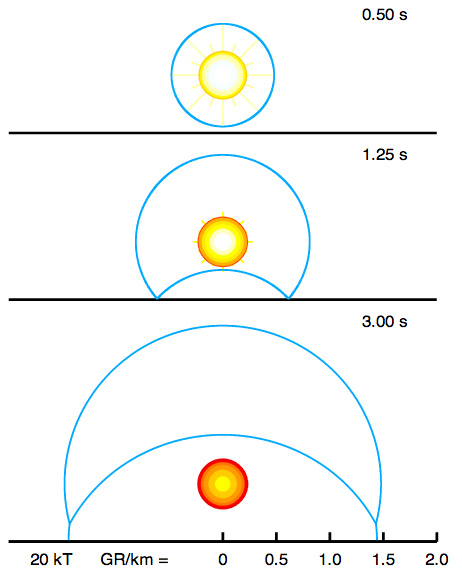
Reflection of the shockwave of a 20 kiloton nuclear explosion exploded at 1,770 foot altitude. Via Wikipedia.
You don’t have to take my word for it (or Wikipedia’s, for that matter) — you can actually see the reflection of the shockwave in some nuclear testing photography, like this photograph of Shot Grable, the “atomic cannon” test from 1953:
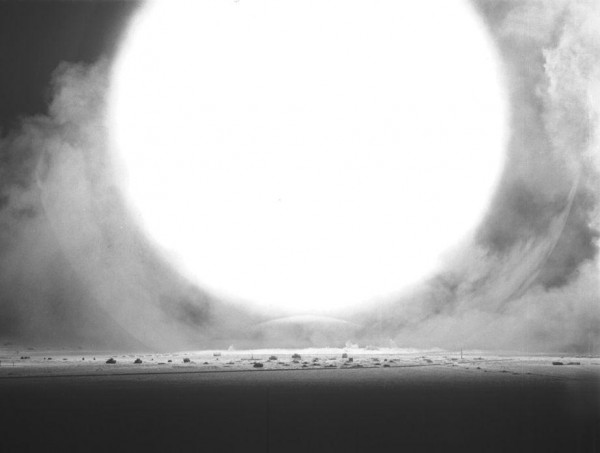
Shot Grable, Operation Upshot-Knothole — a 15 kiloton nuclear artillery shell detonated at an altitude of 524 feet, with the reflection of the blast wave clearly visible under the fireball.
The initial blast wave is the “incident” or “primary” blast wave. The bounded wave in the “reflected” wave. When they touch, as shown in the Wikipedia diagram, they combine — which dramatically increases the overpressure at that location. So, referring the Wikipedia diagram again, by the time the primary shockwave was at the final radius of the diagram, it would have lost a considerable amount of energy. But when it merges with the reflected shockwave, it forms a single, vertical shock front known as the “Mach stem.” In the diagram above, that has an overpressure of 15 psi — enough to destroy pretty significant buildings. If the shockwave did not work in this fashion, the primary shockwave would itself be considerably less than 15 psi at that point.
So the overall point here is that blast reflection can dramatically increase the blast pressure of the bomb at the point where it occurs. But the location at this point varies depending on the height of the bomb detonation — so you can use the choice of bomb detonation altitude to maximize certain pressures in particular. So this is what the Target Committee was talking about in May 1945: they wanted to maximize the radius of the 5 psi overpressure range, and they recognized that this involved finding the correct detonation height and knowing the correct yield of the bomb. They knew about the reflection property and in fact referred to the Mach stem explicitly in their discussion. Why 5 psi? Because that is the overpressure used to destroy “soft” targets like the relatively flimsy houses used by Japanese civilians, which they had already realized would be much easier to destroy than German-style houses.
For the NUKEMAP, this reflection made the modeling difficult. There are lots of models out there for calculating overpressure based on altitude, but they all do it similar to the Lovelace Foundation’s “Computer”: they tell you the maximum overpressure at a pre-specified point from ground zero. They don’t let you ask, “where would the 5 psi radius be for a blast of 15 kilotons and a height of 1,968 feet?” Which was inconvenient for me. The data is out there, though — just not in computational form. Graphs of pressure ranges plotted on axes of ground range and burst height are quite common in the nuclear literature, where they are sometimes known as “knee curves” because of the characteristic “bulge” in ground range produced by the aforementioned Mach reflection, the spot where the pressure range dramatically enlarges. Glasstone and Dolan’s 1977 Effects of Nuclear Weapons contains three of these graphs for pressure ranges between 10,000 and 1 psi. Here is the “low-pressure” graph showing the characteristic “knees”:
Reading these is fairly straightforward once you understand what they show. If you want to maximize the 2 psi pressure range, find the point at which the “2 psi” curve is as far to the right as possible. Then look at the vertical axis to find what the corresponding height of burst is. Or, if you want to know what the pressure will be on the ground at a given distance from a bomb detonated at a given burst height, simply figure out which pressure regions that point is between on the graph. The graphs are always given for 1 kiloton bursts, but scaling from these to arbitrary detonations (with the caveat that very high and very low yields can sometimes be a little different) is pretty straightforward according to the scaling laws given in the text.
I searched high and low for a computational solution to the airburst question, without much luck. I had attempted to do polynomial curve fits on the graphs above, and just found them to be too irregular — the equations I was able to produce made huge errors, and splitting them up into sub-curves produced a mathematical mess. The only other computational solution I found was someone else who had done curve fits and also come up with equations that produced relatively large errors. I wasn’t happy with this. I discussed my frustrations with a few people (let me do a shout out to Edward Geist, currently a Stanton Fellow at the Rand Corporation, who has been doing his own modeling work regarding Soviet nuclear effects handbooks, and to Alex Montgomery at Reed College, both of whom were extremely helpful as people to talk to about this), and gradually came to the conclusion that there probably wasn’t an obvious analytical solution to this problem. So I did the next-best thing, which was to take samples of all of the curve values (less tedious than it sounds because of a little script I whipped up for the job) and just set up some tables of data that could then be sifted through very quickly by the computer. In other words, the way the NUKEMAP’s code works is pretty much the Javascript equivalent to consulting the graphs in Glasstone and Dolan’s book — it treats it as a simple interpolation problem between known values. Which turns out to give results which are no worse than those involved with using the book itself:
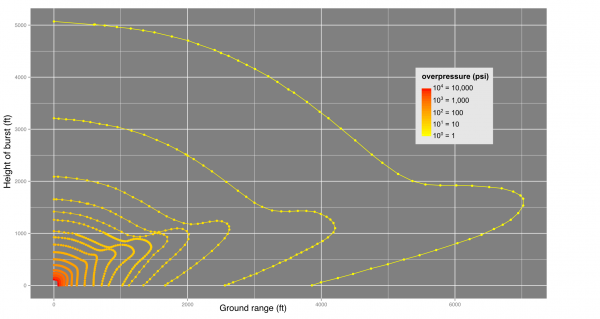
The NUKEMAP’s overpressure data, graphed using R. Point samples are represented by circles, lines connect given pressure ranges. Color corresponds (logarithmically) with pressure ranges from 1 to 10,000 psi. Unknown points on the graph are interpolated between known values.
The end result is that now the NUKEMAP can do arbitrary-burst height airbursts. In fact, the NUKEMAP pressure model goes all the way up to 10,000 psi — a pressure zone equivalent to being 4 miles under the ocean. Yow.
With this data in hand, and the NUKEMAP model, let’s go back to the Hiroshima and Nagasaki question. They knew about the Mach reflection, they knew about the height of the burst. It’s not clear that their assumptions for how this would work would line up exactly with those in Glasstone and Dolan, since those were modified according to actual empirical experience with airbursts in the kiloton range, something that they did not have on hand in 1945, even if they intuited much of the physics behind it. What can we say about their knowledge, and their choices, with regards to what they actually did with selecting the blast heights?
The Hiroshima yield has been calculated as about 15 kilotons, and the Nagasaki yield was about 21 kilotons. According to the Glasstone and Dolan model, to optimize the 5 psi pressure range for each, you’d want a burst height of ~2,500 feet for Little Boy and ~2,800 feet for Fat Man. Those are significantly higher altitudes than the actual detonation heights of 1,968 and 1,650 feet. The Target Committee meeting shows that they were assuming that 2,400 feet was the correct height for a 15 kiloton bomb — which is about right. Which means either than the detonating circuitry fired late (not impossible though I haven’t seen it mentioned), or they changed their blast range criteria (for a 15 kiloton bomb, 1,940 feet maximizes the 9 psi radius rather than the 5 psi radius), or that they were being very conservative about the yields (a 1,960 feet burst height corresponds with maximizing the 5 psi radius of a 7 kiloton burst, whereas 1,700 feet corresponds to a 5 kiloton burst). My guess is that the latter was what was going on — they were being very conservative about the yield.
The net result is that at both Hiroshima and Nagasaki, you had lower burst heights than were optimal. The effect on the ground is that while the 5 psi blast radius didn’t go quite as far out as it might have ideally, the range of radiation effects and radiation around Ground Zero was significantly increased, and the maximum overpressures around Ground Zero were substantially higher. Overall, it is interesting to see that they were apparently, even after Trinity, still being pretty un-optimistic regarding the explosive yields of the bombs, calibrating their burst heights to half or even one quarter of what the actual blasts were. For a “soft” targets, like Hiroshima and Nagasaki, this doesn’t matter too much, as long as the fireball is above the altitude which produces local fallout, but for a “hard” target, where the goal is to put a lot of pressure in one spot, this would be a serious miscalculation.
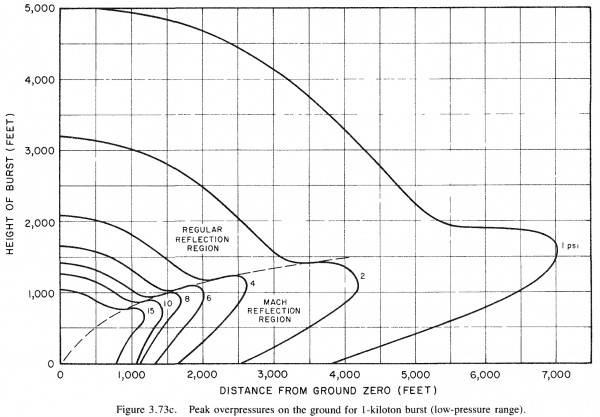


So, how did they calculate the curves for the book?
They don’t say, but presumably it is a mixture of theoretical and experimental considerations, like most of the book. I have seen some reports which suggest that there are arguably slight refinements that can be made to these curves (to make the “knees” sharper), but for my purposes I don’t really want to worry about that. It should be noted that these are considered somewhat ideal curves and that irregular terrain and other local conditions can obviously affect the final outcome.
—I would still like to know if Jack Raper, in his August 1945 column about Hiroshima, admitted that he had gotten Los Alamos wrong, that there was no “engine stopping ray.” And, if so, if he said something like “I knew, but I wasn’t going to say it.” or, “boy, they sure did pull one over on me. I’ll never play cards with those guys again!”
—I thought my local library had the Cleveland Press on microfilm. It does not.
This is probably the refinement to NUKEMAP that excites me the most. As you’ve discussed before, the 5 psi overpressure is effective against lightly-constructed US and Japanese houses, but ineffective against substantial European construction. A little experimentation shows that optimising for 5 psi overpressure gives a burst height too high for any area to receive 20 psi overpressure, potentially resulting in very limited damage against some targets that would be obliterated in the USA.
Great job Alex, NUKEMAP keeps getting better and better.
Do you plan to convert pressure levels to Pascals in the future? IIRC pressure it’s the only quantity in Nukemap’s output not displayed in SI units (to be extra pedantic, i’ve just noticed that the radiant energy is in cal*cm^-2 instead of J*m^-2).
Keep up the good work 😀
All of the physical units are displayed in good ol’ American Cold War units (psi, cal*cm^2, and rem), but it would not be hard to add an automatic converter similar to the one that allows you to quickly switch between imperial and metric units. Maybe one of these afternoons I’ll throw that together…
Alex good work but the radius for overpressure between 50-100 psi are completely wrong.
That’s an odd comment to leave — it matches up rather perfectly with the curves of figure 3.73b in Glasstone and Dolan, and the interpolations seem as sane as anything else. What’s your reason for thinking so? (And why would 50-100 psi be any different than any of the other ranges, which are derived from the exact same sort of data?)
1000kt surface burst: result from NukeMap
200 psi: 0.8km
100 psi: 1.04km
90 psi: 4.05km
70 psi: 4.06km
50 psi: 1.4km
20 psi: 2.18km
As you can see 90/70 psi radius > 50/20 psi radius so there is a problem.
Ah, I see what you are saying. There seems to be an error in the interpolation code in general that shows up at certain settings. I’ll squash it ASAP!
So this turned out to be related to the fact that interpolating between knee curves is a non-trivial affair! But I worked on this over the weekend and the code now gives much better results. Thanks for pointing this out.
Er, there still seems to be some weird pressure reversal errors like E.T said. I just put in a 10kt 5 psi optimize burst, and it spit out a 2.5 psi range that was at 5.75 miles while 1 psi was only 2.65… Is this just a random little bug or are there still interpolating errors?
Hmm, that’s weird! In my PHP version of the code, it works fine, but the Javascript version does occasionally produce a weird error in the 2.5 psi (interpolated between 2 and 4 psi) range. I’ll check it out today, it must just be some kind of code error (Javascript and PHP sometimes both handle variables somewhat differently, so there are subtle places for possible error to creep in). Thanks for letting me know!
OK — I think it is now fixed! It in fact was a rather trivial PHP/Javascript difference that was hidden away in the code. (It had to do with how Javascript and PHP differently deal with comparative operations on undefined variables.)
Oh, and there’s another bug that I’ve been seeing too: whenever I input large yields, (usually past 20 Mt) NUKEMAP consistently gives me errors in things like thermal radiation values and ranges and refuses to calculate them.
(On a completely unrelated side note, are you going to update NUKEMAP 3D with this new airburst data?)
Can you give me an exact settings that produce the behavior?
Re: NUKEMAP3D — I don’t have any plans to add the more complicated airburst code to it anytime too soon, just because I find the NUKEMAP3D interface complicated enough as it is. In my mind I think of NUKEMAP3D as being almost entirely about the spectacle of the cloud (and doing that for arbitrary heights could be quite difficult) and NUKEMAP is more about the details.
Thermal Radiation Range data from Nukemap, all of these are airbursts at optimum altitude:
20 Mt: No error
30-40 Mt: Error on Thermal radiation radius (no harm) value
50-70 Mt: Error on Thermal radiation radius (1st degree burns (50%)) value
80-100 Mt: Error on Thermal radiation radius (2nd degree burns (50%)) value
The exact error message (for example, a 50 Mt burst) is:
The following errors were encountered trying to implement these settings:
Thermal radiation (1st degree burns (50%)) equation failed to give a result for the given yield and height.
Thermal radiation (no harm) equation failed to give a result for the given yield and height.
Also, it seems to start giving back error messages at around very specific yield: (again, only for optimum airbursts) 22825.77 Kt, or 22.825770000000002 Mt.
This same kind of effect also happens around low ranges as well, below .35 Kt. Maybe it’s just something to do with overscaling, the site itself says that anything below 1 Kt or above 30 megatons is based of of scaling of other data points IIRC
Hi Alex there is still the problem with the 50-100 psi pressure. The range for these pressure are always wrong.
1000kt surface burst:
Air blast radius (20 psi): 2.18 km (14.9 km²)
At 20 psi overpressure, heavily built concrete buildings are severely damaged or demolished; fatalities approach 100%.
Air blast radius (95 psi): 4.05 km (51.4 km²)
Air blast radius (90 psi): 4.05 km (51.5 km²)
Air blast radius (80 psi): 4.05 km (51.6 km²)
Air blast radius (70 psi): 4.06 km (51.7 km²)
Air blast radius (60 psi): 4.06 km (51.8 km²)
Air blast radius (55 psi): 4.06 km (51.8 km²)
As you can see the range for 55/60/70/80/90/95 psi is superior to the range for 20 psi.
I think you might just need to do a hard refresh of the page with your browser (hold down shift, click reload/refresh). On mine the values are correct with the new code:
Air blast radius (95 psi): 1.08 km (3.65 km²)
Air blast radius (90 psi): 1.11 km (3.9 km²)
Air blast radius (80 psi): 1.19 km (4.41 km²)
Air blast radius (70 psi): 1.26 km (4.96 km²)
Air blast radius (60 psi): 1.33 km (5.54 km²)
Air blast radius (55 psi): 1.36 km (5.84 km²)
Air blast radius (20 psi): 2.18 km (14.9 km²)
Any progress on fixing the thermal radiation range bug?
Yeah, it is just that it ends up scaling it beyond the parameters of the model. It can probably be extrapolated from, though. I should have something changed in a day or two; I’m on the road right now.
OK — the thermal radiation extrapolation calculations for >20 Mt and <1 kt have been updated and are giving more sane results. (The "probe" function doesn't really work well at these extremes, but it now gives a little message alerting to this effect.) You might need to do a hard refresh (shift + reload page) for your browser to update its copy of the file.
It would seem to me that the tactical battlefield use of nuclear weapons is where the airburst vs. groundburst decision is especially difficult. To use a not entirely improbably example, suppose an American unit is in grave danger of being overrun by a massive Iranian tank assault. A groundburst would maximize destruction among the armored enemy forces, but the resulting fallout might put the Americans at risk. What do you do?
Low airburst, you won’t get quite so much destruction at ground zero but tanks aren’t that hard (I figure 20 psi or so… it’s actually a dynamic pressure effect, though) so you’ll kill them further out and have negligible fallout. Have your guys button up, get the decon units up and running, and you should be okay.
Cooper’s Explosives Engineering will show you what you’re looking for.
Perhaps a future version of NUKEMAP could do a finite element analysis on the fly, which could take into account local geography!
I’ve thought of ways to take into account local geography. Terrain altitude data is actually accessible through the Google Elevation API. So in theory you could have it sample a lot of local points and then incorporate that into the effects coding. Not going to happen anytime soon, though.
The more useful thing would be to be able to access information about building type and density, but that doesn’t seem to be in the cards at the moment. There are databases for some cities in the USA regarding this but I’d want any solution to be international by default.
I have figured out at least one method for detecting whether water is at any given point (including lakes) but it is a drain on the server (it requires server-side image processing) and seems to be of only very marginal benefit. In a very, very early beta of NUKEMAP3D it used to color the mushroom cloud white if over water. A cool little feature but not worth crippling the server for.
[…] dominated by scientists in attendance. Along with discussing the ideal burst altitude of the bomb, calculated to destroy the largest amount of “light” buildings (e.g. housing), the scientists also discussed targets. At this point, the target list was #1 Kyoto, #2 Hiroshima, […]
[…] the broader picture. I don’t happen to think that myself — much of the broader picture is in fact embedded in the technical details, and “new” discussions of technical details are one way of shaking people out of the […]
[…] answer one other question that comes up: would such a demonstration create deadly fallout? Not if it was set to detonate high in the air, like at Hiroshima and Nagasaki. If it was detonated underwater the fallout would be mostly limited to the area around the bomb […]